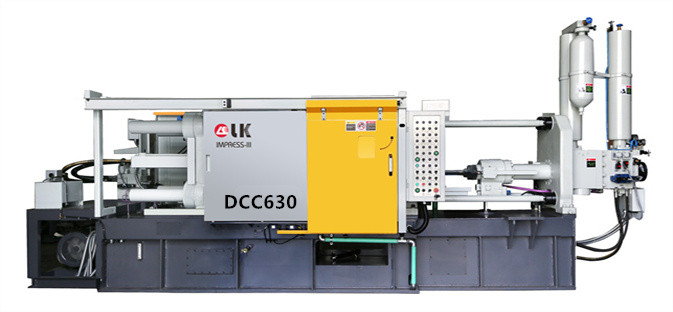Aluminum Die Casting Defects
LK Die Casting Machine / 2024-07-26 11:23:13
2024-07-26 By Cherry
Aluminum die casting is a common metal-forming process, but some defects are inevitable during the production process.
Overview of aluminum die casting defects
Common defect types
Aluminum die casting defects mainly include the following types:
1. Zinc point: zinc deposits formed on the surface of aluminum die castings, usually caused by zinc contamination in the mold or smelting process.
2. Aluminum casting porosity: small pores inside or on the surface of aluminum die castings, affecting the mechanical properties and surface quality
of the material.
3. Casting draft: improper draft angles in mold design, resulting in difficult demolding or surface defects in the casting.

Casting draft and mold design
The casting draft means that in the mold design, in order to ensure that the casting can be de-molded smoothly, a certain slope must be designed
on the vertical surface of the casting.
This slope is usually between 0.5 and 3 degrees. The design of the draft angle directly affects the quality and production efficiency of the casting.
Aluminum cast house process
The aluminum cast house process includes the following key steps:
1. Mold design and manufacturing: CAD software is used to design the mold, and high-precision CNC machine tools are used for processing.
2. Melting and casting: Melt the aluminum ingot to an appropriate temperature, use a furnace to maintain a stable temperature, and ensure the fluidity
and purity of the aluminum liquid.
3. Cooling and demolding: After casting, the casting needs to be quickly cooled and demolded. The cooling rate directly affects the internal structure
and surface quality of the casting.
Aluminium density kg/mm3
The aluminium density is 2.7 kg/mm3, which makes aluminum alloys widely used in aviation, automobiles, and other fields. Compared with other
metals, aluminum has a lower density and has excellent lightweight advantages.
Aluminum casting porosity
Aluminum casting porosity refers to the proportion of pores or shrinkage pores present inside the casting. High porosity will reduce
the mechanical properties and corrosion resistance of the casting. The key to controlling porosity is to optimize the smelting and casting
process to ensure the fluidity and filling performance of the aluminum liquid.
Generation and prevention of zinc point
The generation of zinc point is mainly due to zinc contamination in the mold or smelting process. Prevention and control measures include:
1. Mold cleaning: Clean the mold regularly to avoid zinc contamination.
2. Smelting control: Strictly control the temperature and time during the smelting process to avoid zinc impurities from mixing into the
aluminum liquid.

Chrome vs polished chrome
The surface treatment of aluminum die castings often uses chrome vs polished chrome processes.
Polished chrome can improve the corrosion resistance and surface hardness of the casting, while polished chrome can further improve
the finish and aesthetics of the casting.
Magnesium alloy vs aluminium
Magnesium alloy vs aluminium alloy are two common lightweight alloy materials. Magnesium alloy has a lower density of about 1.74 kg/mm3,
while aluminum alloy has a density of 2.7 kg/mm3. Both have their own advantages and disadvantages in mechanical properties and corrosion resistance.
Magnesium and aluminum weight
The weight of magnesium is only 2/3 of that of aluminum, so magnesium alloys are more advantageous in applications that require extremely
light weight. However, aluminum alloys have better corrosion resistance and mechanical strength, so they are still the preferred material in most applications.
Yield stress of cast iron and aluminum alloy
The yield stress of cast iron is usually between 200-300 MPa, while the yield stress of aluminum alloy is between 50-400 MPa, depending on the
alloy composition and heat treatment process.
Although aluminum alloys have lower yield stress, they still have obvious advantages in many structural applications due to their lightweight
properties. Use of mold tin is a commonly used mold material with good thermal conductivity and wear resistance.
Mold tin alloys are often used in aluminum die-casting molds to ensure the quality and production efficiency of castings.
Anodized vs e coating
The surface treatment of aluminum die castings can be done by anodizing and electroplating.
Anodized parts can improve the corrosion resistance and surface hardness of aluminum, while e coating can give castings a different appearance
and functional characteristics.
Ezac and Recycled Aluminum Countertops
Izak is an advanced aluminum alloy casting technology with high precision and high efficiency. Recycled aluminum countertops are high-performance
countertops made of recycled aluminum materials, which have environmental and economic advantages.
Aluminum die casting is a complex and delicate process that is prone to various defects.
By deeply understanding these defects and their causes, and adopting scientific and reasonable process control methods, the quality and production
efficiency of aluminum die castings can be effectively improved.
It is hoped that this article can provide valuable reference and guidance for technicians engaged in the aluminum die casting industry.
For more info, you can refer to: https://www.youtube.com/shorts/JLX410QV_kw
Contact LK Egypt to learn more info about the die-casting machine
LK AGENT OFFICE DCM
Address: Industry Zone, South of Port Said Kebly, Egypt
https://www.zazdiecasting.com/
Phone/WhatsApp/Wechat: +86 13598704163
Mobile: +20 101 304 3317 +20 150 181 8310
Email: jack@zazmae.com ahmedmahmoud@zazmae.com
OTHER CONTENT
-

2024-09-19 14:16:15 LK Cold Chamber Die Casting Machine DCC900 Locking Force: 9000KN Die Height: 400-1000mm Space Between Tie Bars: 930x930mm Shot Weight: 13.5Kg Casting Area Max:2250c㎡
More -

2024-09-19 14:11:06 LK Cold Chamber Die Casting Machine DCC280 Locking Force: 2800KN Die Height: 250-650mm Space Between Tie Bars: 560x560mm Shot Weight: 2.9Kg Casting Area Max:700c㎡
More -

2024-09-19 10:23:07 LK Cold Chamber Die Casting Machine DCC580 Locking Force: 5000KN Die Heigh: 350-850mm Space Between Tie Bars: 760x760mm Shot Weight: 6.9Kg Casting Area Max:1250c㎡
More -

2024-09-19 10:11:20 LK Cold Chamber Die Casting Machine DCC400 Locking Force: 4000KN Die Height: 300-700mm Space Between Tie Bars: 669x669mm Shot Weight: 4.7Kg Casting Area Max:1000c㎡
More

